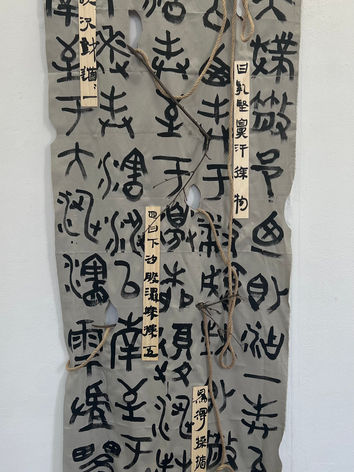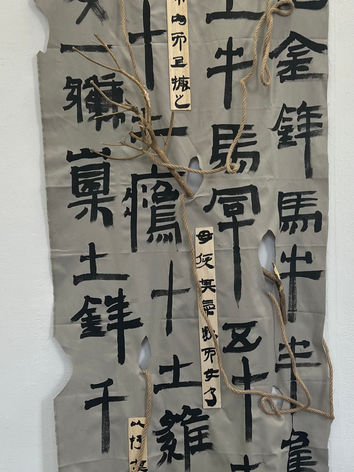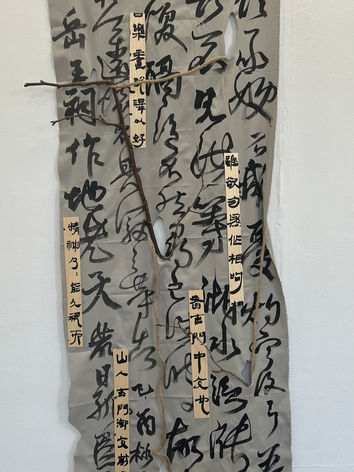MA Fine Art Summer Show July 4th---10th 2023

July 2023
200cm*72.5cm*4Cloth, Light Silk, Chinese Ink, Hemp Rope, Wooden Strip, Nail


My work delves deeply into a critical examination of traditional Chinese family ideals. It navigates the complex interplay between control and constraint, acknowledging a yearning to break free from these culturally ingrained family norms while simultaneously paying tribute to the enduring power and significance of these traditions.
Material layering plays a pivotal role in conveying the multifaceted nature of these conflicting concepts. The use of diverse elements such as oracle bone inscriptions, metal inscriptions, bamboo slips, fabric, found objects, and Chinese calligraphy adds depth and texture to the artwork.
The two distinct layers of the piece are particularly noteworthy. The top layer, a white cotton with a subtle sheen, represents a surface that might initially seem pristine and unencumbered. However, this is where the contrast and complexity lie, as beneath this layer lies a deep reservoir of formal text content, which symbolizes the enduring restrictions and family rules that have persisted in traditional Chinese families throughout history.
The utilization of various writing styles, including cursive, oracle bone inscriptions, metal inscriptions, and bamboo slips, contributes to the visual and cultural richness of the work. The layering of these materials and textural elements underscores the intricate relationship between tradition and the desire for liberation within the context of family dynamics, making it a powerful commentary on the evolving nature of Chinese family ideals.
Gallery:
The primary goal of this project is to use flat drawing and collage techniques to create a more accurate representation of the final product. By employing flat drawing techniques, the project aims to capture the essence of the final product in a simplified yet visually appealing manner. Additionally, the incorporation of collage techniques allows for a dynamic and multidimensional representation, enhancing the overall accuracy and depth of the final outcome.
The contents of these works are essentially the same; they are all about some important events in the history of this dynasty or record some of the achievements made by the emperor, so that the people of the future generations remember what their ancestors have done. The four works of four styles of calligraphy are the symbol of the turning point of each dynasty. The collage on the cloth wants to express that each generation has been progressing, learning from the experience of the previous generation and then innovating to create their own order of the dynasty, so the collage of bamboo pieces is covered with the original works. This artistic representation showcases the continuous evolution and growth of each dynasty as they build upon the foundations laid by their predecessors. The collage of bamboo pieces, adorned with the original works, symbolises the seamless transition and development from one generation to another, highlighting the importance of learning from history while forging a unique path forward.

Art has long been a mirror reflecting the stories and secrets of our cultural history, concealing and revealing the intricate layers of our past. In this analysis, we will delve into the interplay of concealment, binding, image text, layering, language, materiality, and the relationships between language and form as they intersect with the dynastic narratives presented in these works.
These works, each chronicling significant events in their respective dynasties, serve as a binding force, connecting us to our cultural history. They are a testament to the tradition of documenting the achievements of emperors, ensuring that the memories of past generations are carried into the future.
Concealmentin these artworks serves a dual purpose. While they reveal the achievements and events of each dynasty, they also conceal the intricacies of the past. Beneath the surface, concealed layers represent the hidden struggles, aspirations, and, at times, painful secrets of the dynasties.
The inclusion of image text further deepens the connection between language and form. The calligraphy style chosen for each work is symbolic of the turning points in each dynasty. The text serves as a linguistic layer, narrating the stories and accomplishments of the emperors and their reigns. It is an integral part of the artwork, woven into its visual fabric.
Layering, as seen in the collage of bamboo pieces, symbolizes the continuity and growth of each dynasty. This layering represents the inheritance of knowledge and experience from one generation to the next.
Materials: wood chips, ink
2023
The original works beneath the bamboo pieces reflect the foundational elements on which subsequent dynasties built their legacies. It conveys a message of progress, innovation, and the pursuit of an evolving dynasty.
**Materiality** plays a significant role in the texture of these works. The choice of bamboo as a material holds cultural significance, emphasizing its role in tradition and the transmission of knowledge from one generation to the next. The materiality of the artworks reinforces the concept that cultural history is bound by shared materials, experiences, and the resilience of the dynasty.
The intertwined **language and form relationships** are evident in the calligraphic presentation and its fusion with visual art. The calligraphy and its arrangement in the artworks tell a story that transcends mere words. The form of the artwork accentuates the message conveyed through language, creating a synergy that is uniquely artistic.
In conclusion, these artworks serve as a testament to the dynastic histories that they represent. They simultaneously conceal and reveal the intricacies of each era, holding within them not only the achievements and events but also the silent narratives and painful secrets of our cultural history. Through layering, materiality, and the relationship between language and form, they communicate the essence of each dynasty's progress and growth, emphasizing the importance of learning from the past while forging a unique path forward, like the seamless transition from one layer to the next.

Material: Sketch paper, copy paper, ink, black line
2023
These exercises allow artists to experiment with different techniques and materials, helping them understand how colours, lines, and textures interact on a two-dimensional surface. By exploring various compositions and styles in the sketchbook, artists can refine their ideas and make informed decisions when creating the final artwork.

Material:A4 sketchbook, ink, collage, fine twine.
2023

Material: Foam board, acrylic paint, ink, fine twine, glass bowl, UV adhesive, sulphuric acid paper, transparent plastic paper.
Creation of experimental demos on 30 May 2023
The above are my artistic exercises and experiments for the final works of the summer exhibition in July, in which I tried to integrate different materials, like a family. Everyone is a different individual existence, but because of the blood and the feudal patriarchal system, everyone cannot erase the edges to become whole. This integration of materials mirrors the complexities of human relationships, where individuals are connected through shared experiences and societal structures. Just as each material in my artwork retains its unique characteristics, every family member retains their individuality within the larger unit. However, the influence of blood ties and societal norms creates a sense of interconnectedness that cannot be easily erased, ultimately shaping the dynamics of the family as a whole.
3D rendering using 3D apps
July 2023
"I don’t understand your drawing "
Drawing research exhibition Camberwell masters students
Exhibition C132, 6 October 2023
Length and width:17.5cm*13cm*3
Acrylic paint, Chinese rice paper, ink, glue, thin linen rope
As a way to represent custom, kinship, and tree branches, the text uses the idea of bound string lines.
1. Can you identify a moment during the Camberwell MA Drawing journey, where
your relationship to drawing either shifted or became clear in terms of a specific
research practice focused on drawing.
The pivotal moment came during a workshop where I found myself bursting with inspiration and
ideas related to my theme. As I began drawing, these fragmented ideas started to coalesce, taking
on a tangible form on the paper. This was the moment when I realized that my process was
inherently dynamic, that drawing and research were not separate entities but intertwined in a
continuous, iterative cycle.
This transformative moment clarified the theoretical and intellectual underpinnings of my work,
emphasizing that my approach to drawing was rooted in both the act of creation and the act of
research. I came to understand that drawing wasn't solely about technique; it was a powerful
means of inquiry, capable of exploring complex ideas and themes.
2.What is drawing research within your practice?
The utilization of line serves as a formal device, while also carrying a deeper symbolic meaning.
use the imagery of trees to symbolize the family tree and the bonds of blood; anchoring the work
in a personal and universal narrative. It is within this context that I embarked on a form of "drawing
research"
My specialization in line work is a deliberate choice to investigate the visual and conceptual
possibilities inherent in the medium. The recurring use of lines, and trees as symbols within a family
context suggests a sustained inquiry into the intricacies of familial relationships, genealogy, and
individual identity within the collective whole.
Fluid acrylics are a noteworthy addition to the process; flowing together to underscore the
complexity of familial bonds. I convey a sense of unity and interconnectedness through the fusion
of colors and forms, mirroring the idea that despite the desire for individuality, family members
remain interwoven and inseparable.
I work in sequence to communicate a larger story or journey, extending the boundaries of
traditional drawing into narrative exploration. This approach can be seen as a form of research into
how the theme of family and individuality evolves and transforms over time. Drawing research
within this practice is not merely a technical exercise but an inquiry into the complexities of human
relationships, communicated through a visual language that merges tradition with contemporary
sensibilities.


The following two movies were shot during the creation process and the overall impact on the day of the show. my exhibition is a small-scale demonstration of my profession, therefore each of my works is little.
The following two movies were shot during the creation process and the overall impact on the day of the show. my exhibition is a small-scale demonstration of my profession, therefore each of my works is little.






